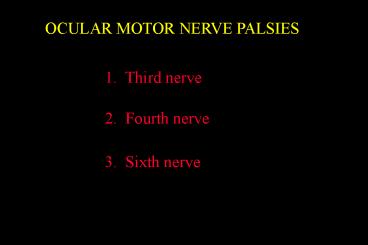OCULAR MOTOR NERVE PALSIES - PowerPoint PPT Presentation
1 / 15
Title:
OCULAR MOTOR NERVE PALSIES
Description:
Sixth nerve Anatomy of third nerve Oculomotor nucleus Pituitary gland Carotid ... artery IV Signs of right fourth nerve palsy Right overaction on left gaze ... – PowerPoint PPT presentation
Number of Views:421
Avg rating:3.0/5.0
Title: OCULAR MOTOR NERVE PALSIES
1
OCULAR MOTOR NERVE PALSIES
1. Third nerve
2. Fourth nerve
3. Sixth nerve
2
Anatomy of third nerve
Oculomotor nucleus
Pituitary gland
Red nucleus
Carotid artery
Cavernous sinus
Pons
III nerve
Post cerebral artery
Clivus
Basilar artery
3
Applied anatomy of pupillomotor nerve fibres
Blood vessels on pia mater supply surface
of the nerve including pupillary
fibres ( damaged by compressive lesions )
Vasa nervorum supply part of nerve but not
pupillary fibres ( damaged by medical lesions )
Pupillary fibres lie dorsal and peripheral
4
Signs of right third nerve palsy
- Ptosis, mydriasis and cycloplegia
- Abduction in primary position
- Normal abduction
- Intorsion on attempted
- downgaze
- Limited depression
- Limited adduction
- Limited elevation
5
Hess chart of right third nerve palsy
- Contraction of right chart and expansion of
left - Right chart - underactions of all muscles
except lateral rectus and superior oblique - Left chart - overactions of all muscles except
medial rectus and inferior oblique
6
Important causes of isolated third nerve palsy
Idiopathic - about 25 Vascular disease -
hypertension, diabetes
Posterior communicating aneurysm
Trauma
Extradural haematoma
Aneurysm
Chiasm
Midbrain pushed across
Edge of tentorium
Prolapsing temporal lobe
Posterior cerebral artery
Third nerve
7
Anatomy of fourth nerve
8
Signs of right fourth nerve palsy
- Right underaction on depression
- in adduction
- Vertical diplopia
- Right hyperdeviation in primary
- position when left eye fixating
- Excyclotorsion
- Right overaction on left gaze
9
Positive Bielschowsky test in right fourth nerve
palsy
Absence of right hyperdeviation on
contralateral head tilt
Increase in right hyperdeviation on ipsilateral
head tilt
10
Hess chart of right fourth nerve palsy
- No significant difference in chart size
- Upward deviation of right fixation spot on
inner chart (hypertropia) - Downward deviation of left fixation spot on
inner chart - Right chart - underaction of superior oblique
and overaction of inferior oblique - Left chart - overaction of inferior rectus and
underaction of superior rectus
11
Anatomy of sixth nerve
Basilar artery
Pituitary gland
Medial lemniscus
Carotid artery
4th ventricle
Cavernous sinus
Petroclinoid ligament
Clivus
Vestibular nucleus
VI nerve
Pyramidal tract
12
Recent right sixth nerve palsy
Right esotropia in primary position due to
unopposed action of right medial rectus
Marked limitation of right abduction due to right
lateral rectus weakness
13
Hess chart of recent right sixth nerve palsy
- Contraction of right chart and expansion of
left - Right chart - marked underaction of lateral
rectus and mild overaction of medial rectus - Left chart - marked overaction of medial rectus
14
Old right sixth nerve palsy
Straight in primary position due to partial
recovery
Limitation of right abduction and horizontal
diplopia
Normal right adduction
15
Important causes of isolated sixth nerve palsy
Vascular - hypertension, diabetes
Acoustic neuroma
Raised intracranial pressure
Dilated ventricles
Petrous tip
Brainstem pushed downwards

